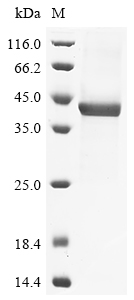In the baculovirus expression system, the recombinant human prostatic acid phosphatase (ACP3) is expressed by using a baculovirus transfer vector. The gene fragment encoding the desired region of human ACP3 (33-382aa) along with a terminal 10xHis-tag, is inserted into the transfer vector under the control of baculovirus-specific regulatory elements, including a promoter and terminator. The transfer vector is co-transfected into vector producer cells along with a baculovirus DNA construct, which provides essential replication and structural proteins necessary for the propagation of the recombinant baculovirus particles. The recombinant baculovirus transfects the insect cells, which provides a suitable cellular environment for the recombinant ACP3 protein expression. The expressed recombinant ACP3 protein is purified from the cell lysate. Its purity is over 85% as determined by SDS-PAGE. It migrated onto a band of 44 molecular weight on the gel.






